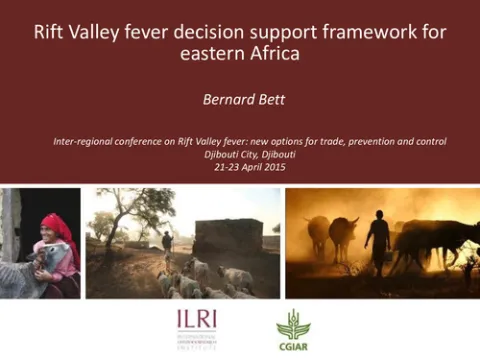Rift Valley fever decision support framework for eastern Africa

Abstract
In the eastern Africa region, Rift Valley fever (RVF) epidemics occur in irregular cycles that make it
difficult for mitigation agents to implement effective interventions in the face of an outbreak.
Furthermore, the existing prediction systems do not offer an adequate lead time given that there is
inadequate knowledge on drivers and processes that promote outbreaks. The Rift Valley fever (RVF)
Decision Support Framework (DSF) has therefore been developed to guide timely, evidenced based
decision-making in the control of the disease considering that uncertainties on decision making can
paralyse the deployment of effective response measures. The last (2006/2007) outbreak for instance
caused substantial socio-economic impacts in the region due to by delays in the recognition of risk
and in making decisions to control the disease.
The framework breaks the RVF epidemic cycle into five explicit steps and matches them with
appropriate actions. These steps identified in the framework include: (i) inter-epidemic period, (ii)
pre-outbreak period (classified into early warning, localised rain, flooding and mosquito swarms), (iii)
outbreak period (classified into suspected and confirmed outbreak sub-phases), (iv) recovery phase
including a 45-day period when no further livestock cases are observed, and (v) post-outbreak
recovery and reflection. Interventions matched to these epidemic stages are: capacity building and
training, communication, advocacy and public awareness, national and regional coordination, early
warning, surveillance, disease prevention, case management, regulation of trade and markets for
livestock, resource mobilisation, establishing or strengthening institutions and policies, and risk and
impact assessment. The development of the framework has involved multiple partners, decisionmakers
to ensure ownership and relevance to the decision-making challenges that have been
experienced during previous RVF outbreaks. The framework has also been aligned with the One
Health principles by specifying interventions for both veterinary and human health sectors at each
decision point.
For the framework to be effectively operationalized, three key issues will have to be addressed: (i) a
national RVF emergency fund has been established and procedures and modalities put in place to
enable the fund to be made available rapidly in response to predetermined criteria, (ii) an effective
communication system has been established including a clear chain of command and feedback from
the Chief Veterinary/Medical Officers to field officers and communities, and (iii) that approved RVF
Contingency Plans integrate the framework in their designs.
